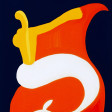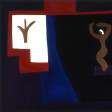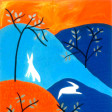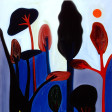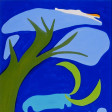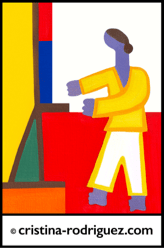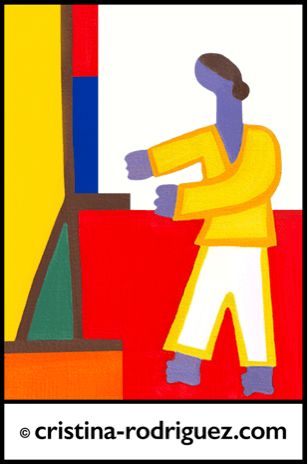Lettre
Chère Cristina,
Je vous remercie pour ces images de chats toujours à la fois bien présents dans la composition de la toile – cependant j'ai remarqué qu'ils y occupent une présence très spéciale (1996) – par leur silhouette, leur volume, leur contour – (il y a un style spécial dans cette série) – ils choisissent une vie, un sorte de présence mouvante, (wandering over their limits) : leur énergie naturelle fait qu'ils excèdent un peu leurs proportions naturelles – beaucoup de sujets sont en liberté, « en évolution » « blooming or expanding over » over their limits, ils sont « en expansion », so to speak, ce qui est la marque de votre création très précisément cette année – là .
(Ça continue bien sûr, en-dessous, dans les années suivantes, à des degrés différents, ).
Vos plans, vos volumes de la vie courante, chats, fenêtres, vont se promener librement en suivant un contour, des frontières et des limites (comme masses) toujours poussés de l'intérieur par une rêverie – vous installez un style dans vos toiles avec une intention LIBEREE, disons, une liberté de « cut out », crossing and wandering over the normal size (c'est là que je trouve quelque chose d'un peu « matissien » dans la masse de vos sujets, dans cette série 1996-97) – la masse de vos volumes s'excède, s'épanche, DEBORDE d'une certaine façon lyrique – c'est une partie de votre inspiration mais cela (overflows, spills over?) et cela donne ces lignes qui mêlent, avec un effet de liberté qui ajoutant au rêve, une liberté formelle une inspiration vagabonde, a drive towards new limits, une poussée intérieure et un dépassement – dans la série de 1996, précisément, AVEC DES LIGNES LIBRES, GRACIEUSES, they seem reduced to the essence of a special graceful slim graphic style – (comme c'est difficile de dire ce que je veux exprimer!!!!) –
En 1996, la toile « Belonging to That Jar », just taking the one third of the upper part, is graphically extrêmement pure, légère, et en même temps, with quite simple means, elles occupe TOUT – elle triomphe avec le graphisme total d'une affiche – un grand poster pour un événement international – mais les moyens sont ultra simplifiés – it's stunning graphically. Pour moi (je souris) qui suis un peu « l'archélogue » de votre travail (pardon pour cette remarque humoristique), je retrouve la même grâce et la même ECONOMIE de moyens (of course, of course, of course!!!)
Dans le « To Mies van der Rohe » – avec une pureté de lignes (évidemment, avec un sujet comme celui-là!), mais là, vraiment, vous êtes très très FORTE – pour le « A Game Without a Name » , c'est exactement pareil, vraiment comparable à la simplicité immatérielle d'un pas de danseuse. Breathtaking.
En 1997, « Characters With Long Ears » (joli titre) CONTINUE CETTE IMPRESSION DE LEGERETE – d'ailleurs, dans cette série de 1997, les « Tortoises », le « The Cuckoo in the Depths of the Woods » et sans doute aussi « The Garden of the Longhorns » ont des caractéristiques semblables. Il y a là une capacité d'abstraction et d'emprise (l'occupation de l'espace si on peut dire) par les volumes et la force de masse des éléments REDUITS – qui dégage une impression très spéciale.
Notez bien que « je ne veux surtout pas vous donner des conseils » (ce serait « sacrilège » comme vous dites) – mais il y a un lyrisme vaste de la ligne (le contour, l'enveloppe qui contient la masse d'un personnage, d'une fleur, d'une fenêtre, etc.) QUI CHERCHE SA LIBERTE SOUS NOS YEUX, dans un effort vivant – enfin, on peut être sensible à cela.
Cette fraîcheur, cet esprit naturel et impulsif-instinctif de votre expression artistique, un peu vagabond, » « libre en toute liberté » très inspiré, très « explorateur de l'espace » est une marque chez vous qui dit comment vous « allez à la conquête de la réalité imaginaire » – (il y a du Braque, il y a de la VISION, de la DIVINATION, des lignes un peu « existantes et floues » un peu matissiennes – pourquoi je pense ça ? – parce que les cut-outs de Matisse, ce n'est pas du dessin d'un autre genre – il DECOUPE DANS LA CHAIR DE LA COULEUR, IL A INVENTE UNE DELIMITATION DES ESPACES, 3PHYSIQUE ET « IMMATERIELLE » (guess what it is, god knows it !!) – (comme couper la peau d'une orange ! Une réalité concrète et physique et « de rêve » qui dépasse tout) (j'ai bien aimé quand vous avez parlé de DE Stael, – continents de couleurs – vous, au moins, vous comprenez tout!!!!) –
J'espère que je ne vous ennuie pas avec tous ces commentaires et que vous ne me taperez pas sur la tête, DE RAGE, parce que je fais des commentaires comme ceux-là sur votre style de peinture. Excusez-moi par avance. Je ne sais pas si je réussis à dire ce que je veux (???).
Eric Levergeois
Philosophe
2015
